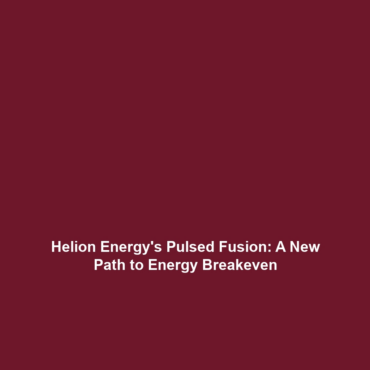History of Fusion Research: A Comprehensive Overview
The history of fusion research is pivotal in understanding the potential of fusion energy as a sustainable and clean energy source. Spanning several decades, this field combines theoretical physics and engineering to unlock the power of the stars. From the early theoretical explorations to contemporary experimental advancements, fusion research continues to evolve, promising to transform global energy systems. This article delves into the significant milestones and concepts within the history of fusion research and their implications for fusion energy.
Key Concepts in Fusion Research
1. Fundamental Principles
Fusion occurs when atomic nuclei combine to form a heavier nucleus, releasing immense energy in the process, much like the reactions occurring in the sun. Key principles central to the field include:
- Plasma Physics: The study of ionized gases critical for sustaining fusion reactions.
- Magnetic Confinement: Techniques like Tokamak and Stellarator that use magnetic fields to maintain high-temperature plasma.
- Inertial Confinement: Utilizing lasers to compress fuel pellets to achieve fusion conditions.
Applications and Real-World Uses
The advancements made in the history of fusion research have led to various applications in the realm of fusion energy. Significant uses include:
- Nuclear Fusion Reactors: Experimental setups like ITER aim to demonstrate commercial viability.
- Energy Generation: Potential for cleaner energy production with minimal radioactive waste compared to fission.
- Medical Applications: Techniques developed for fusion research have been adapted for cancer therapies.
These applications illustrate how the history of fusion research is being utilized to enhance future fusion energy solutions.
Current Challenges in Fusion Research
Despite its promise, the field of fusion energy faces several challenges, such as:
- Technical Limitations: Achieving and sustaining the necessary temperatures and pressures for fusion.
- Cost of Development: Significant financial investment required for research and infrastructure.
- Public Perception: Misunderstandings surrounding safety and environmental impacts.
Addressing the challenges of fusion research is crucial for its advancement and acceptance as a viable energy source.
Future Research and Innovations
The future of fusion research is bright with numerous innovations on the horizon, including:
- Advanced Materials: Development of materials that can withstand extreme conditions within reactors.
- Next-Generation Reactors: Projects like SPARC aim to demonstrate net-positive energy output.
- Quantum Computing: Utilizing quantum technologies to optimize plasma behavior and reactor designs.
These breakthroughs are set to play a pivotal role in shaping the future landscape of fusion energy.
Conclusion
In summary, the history of fusion research represents an essential narrative in developing fusion energy as a sustainable power source. From its foundational concepts to real-world applications and emerging innovations, the field continues to progress amid various challenges. To stay updated on the latest in fusion research, consider exploring other related topics such as Nuclear Energy Technologies or Energy Policy Developments.









